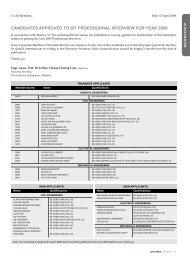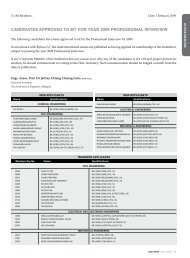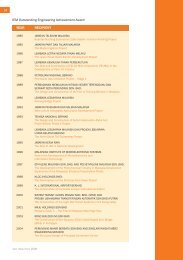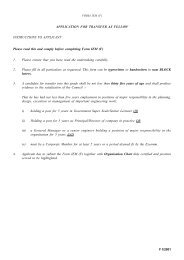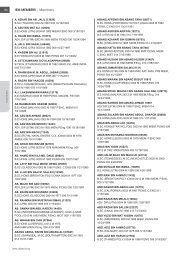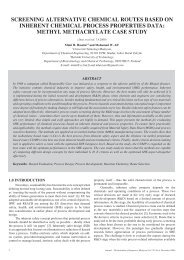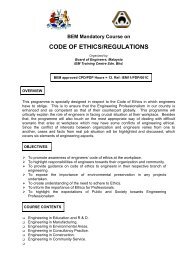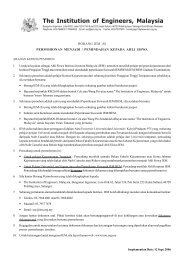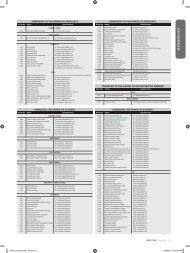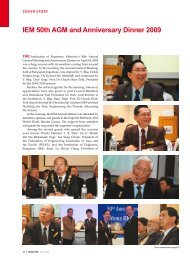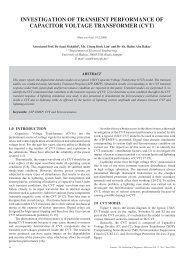Landslide and Debris Flow Risk Management â Hong Kong ...
Landslide and Debris Flow Risk Management â Hong Kong ...
Landslide and Debris Flow Risk Management â Hong Kong ...
- No tags were found...
You also want an ePaper? Increase the reach of your titles
YUMPU automatically turns print PDFs into web optimized ePapers that Google loves.
eportGeotechnical Engineering Technical DivisionHalf-Day Seminar on ‘<strong>L<strong>and</strong>slide</strong> <strong>and</strong><strong>Debris</strong> <strong>Flow</strong> <strong>Risk</strong> <strong>Management</strong> –<strong>Hong</strong> <strong>Kong</strong> Experience’by Engr. Yee Yew Weng, MIEM, P. Eng.On 1 November 2008, a half-daySeminar on ‘<strong>L<strong>and</strong>slide</strong> <strong>and</strong> <strong>Debris</strong><strong>Flow</strong> <strong>Risk</strong> <strong>Management</strong> – <strong>Hong</strong><strong>Kong</strong> Experience’ was organisedat the IEM Conference Hall,Bangunan Ingenieur at 8.30 a.m.Four speakers from the <strong>Hong</strong> <strong>Kong</strong>Institution of Engineers, namely,Albert Ho, Cheung CT, StuartMillis <strong>and</strong> Don Sum shared theirexperience during the seminar.The seminar was attended by 66participants.Ho spoke on the topic of‘<strong>L<strong>and</strong>slide</strong> <strong>Risk</strong> <strong>Management</strong><strong>and</strong> Sustainable Slope GreeningApproach in <strong>Hong</strong> <strong>Kong</strong>’. Heexplained that the <strong>Hong</strong> <strong>Kong</strong> Figure 1: <strong>Risk</strong> reduction approachesGovernment Agency, GEO, wassetup in 1977 after a series ofl<strong>and</strong>slide resulted in the loss of 470 lives. Steps weretaken to reduce the risk of l<strong>and</strong>slide using a three-prongapproach (Figure 1):(i) Reducing l<strong>and</strong>slide consequences• Clear the squatters from hilly terrain• Educate the public to take precaution(ii) Improving slope stability• Upgrad <strong>and</strong> maintain public slopes• Promote private slope maintenance(iii) Containing the increased risk arising from newdevelopments• Check new slopes• Plan l<strong>and</strong> useThe target of the Government by 2010 is to reducel<strong>and</strong>slide risk to less than 25% of that in 1977.Ho explained that the public dem<strong>and</strong> not only safeslopes but also ‘green’ slopes. <strong>Hong</strong> <strong>Kong</strong> has startedusing Continuous Fibre-Reinforced Soil (CFRS) to ‘green’the slopes after engineering treatment. This is a form ofsustainable concept in slope treatment (Figure 2).Figure 2: The sustainable concept in slope treatmentHo said that slope engineering in <strong>Hong</strong> <strong>Kong</strong> hasimproved from a highly empirical form in the 1970s toa more controlled risk l<strong>and</strong>slide management model.In this respect, he gave examples of improvements inGIS, digital photogrammetry, airborne LIDAR, real-timefield instrumentation <strong>and</strong> data transmission, 3D terrainmodelling, etc.Cheung presented on ‘<strong>L<strong>and</strong>slide</strong>s Preventive Worksat Po Shan Road’. The Po Shan area is affected by highgroundwater level <strong>and</strong> is prone to shallow l<strong>and</strong>slides. The26 Jurutera August 2009
eportGeotechnical Engineering Technical Divisionexisting l<strong>and</strong>slide protection measures wereby means of horizontal drains, but these haveshown signs of deteriorating performance.The long term solution was to construct twotunnels measuring 3.5m in diameter <strong>and</strong> 200sub vertical drains. Environmental restrictionmade it necessary to drill the tunnels usingstate-of-the-art ‘Retractable’ TBM (Figure 3).Millis shared his experience on ‘Instrumentation<strong>and</strong> Real Time Monitoring ofNatural Terrain – Hillsides’. Selected problematicslopes were monitored using instrumentssuch as surface monitoring (Figure 4),sub-surface movement, pore water pressure/ground water conditions, soil suction, rainfall,etc. He emphasised that data collection<strong>and</strong> management system must be practical<strong>and</strong> easy to operate.In another presentation, Millis spoke on‘<strong>Debris</strong> <strong>Flow</strong>’. He explained that debris flowis a l<strong>and</strong>slide in which the debris moves bythe dominant mechanism of slurry flow.They are typically of high mobility <strong>and</strong>present greater hazard than debris slides.He gave five examples of destructive debrisflow in <strong>Hong</strong> <strong>Kong</strong> from 1990 to 2008.Millis said that the current framework forinvestigation for <strong>Debris</strong> <strong>Flow</strong> Hazards isprovided in GEO Report 138 ‘Guidelinesfor Natural Terrain Hazard Studies’. Hethen explained the state-of-the-art computermodelling used in hazard studies (Figure 5).Don Sum shared several case studies ofslope works in <strong>Hong</strong> <strong>Kong</strong> in his Lectureentitled ‘Natural Terrain Hazard MitigationWorks at Various Sites in <strong>Hong</strong> <strong>Kong</strong>’. Themitigation works carried out include:(i) tensioned steel mesh fences(ii) rigid barriers(iii) soil nailing(iv) baffles(v) retaining walls(vi) boulder resisting wall (Figure 6)He also highlighted the importance ofinvolving the public in slope work; byencouraging the public to notify theauthorities of possible l<strong>and</strong>slide signs <strong>and</strong> torespond to them.The seminar ended at 12.30 p.m. afterseveral pointed question from the floor. Engr.Yee Yew Weng, Chairman of the GeotechnicalEngineering Technical Division, presentedcertificates <strong>and</strong> tokens of appreciation to thespeakers for their presentations. nFigure 3: Boring using retractable TBMFigure 4: Surface monitoringFigure 5: GIS Modelling of <strong>Debris</strong> <strong>Flow</strong>Figure 6: Boulder resisting wall28 Jurutera August 2009



